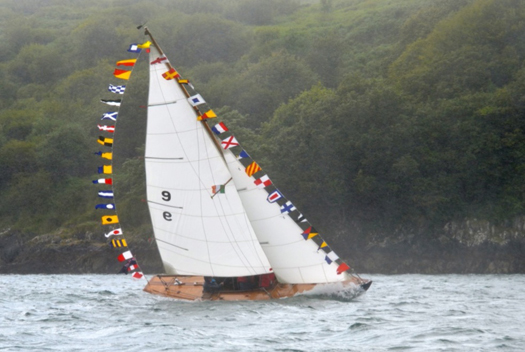#glandoreclassic – Time was when local One Designs really were just that. Utterly local. If you travelled to some attractive sailing centre, there was special interest in the possibility of watching the historic boats unique to the area racing each other in a continuation of inter-family rivalries going back several generations. It was something which added to the fascination of the place - the local boat couldn't be seen anywhere else
But in recent years, it's the classes themselves which have started to do the travelling. Roads have improved, and road trailers have certainly improved. And with the vintage one designs, maintenance can be such a matter of personal dedication that people have become accustomed to bringing the boat home for the winter, rather than making do with whatever facilities may be available on the waterfront.
Once you've started doing that as a matter of course, with road trailing an inevitable part of the mixture, the thought of trundling off to some exotic regatta venue begins to seem natural, however much the home port racing continues to be each local class's ultimate energiser.
It can lead to crazy situations, where elegant little old keelboats find themselves whizzing past each other in opposite directions on some motorway, both groups of boats bound for distant regattas where they'll feature as the ultimate local one design roadshow. This happened on a small scale last weekend, when two of the ancient Howth 17s crossed the bridge from Anglesey on the long road haul from Holyhead to the Solent for the Cowes Classics, while below them on the shores of the Menai Straits, boats of the local Fife One Design class were gearing themselves up on their trailers for the lengthy trek to the Glandore Classics Regatta, which starts today.
The Fifes have been to Glandore several times, and they're an ornament to have about the place. But out of respect for the boat which is going to be the queen of the show, let us first salute the supreme Centenarian star of the Glandore regatta, the pilot cutter Jolie Brise. 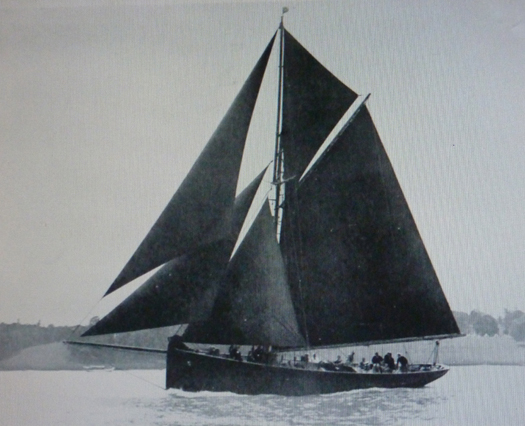
Jolie Brise as she was in 1923 when bought by George Martin, one of the intstigators in 1925 of the Fastnet Race, which she won.
It's ironic that this ship, perhaps the greatest pilot cutter of them all, originated in Le Havre, whereas it was the Bristol Channel which saw the pilot boats most actively developed. Today, the Bristol Channel, while important enough, is no longer in the forefront of the world's shipping waterways. But in Mediaeval times, when merchants and ship's captains tried to move cargoes westward in sailing vessels which could scarcely get to windward at all, the huge tides of the Bristol Channel gave it an inbuilt advantage.
It meant that ships leaving Bristol – which, like Limerick, is virtually in the centre of the country – had a guaranteed favourable conveyor belt every six hours. They shaped their course inshore and anchored as the ebb drew to a close, rode out the flood without losing any ground, and then took the next ebb to make vital westing.
Only a prolonged period of westerly gales would delay the process, and on one occasion in the great days of sail, 800 ships of all sizes became weatherbound in the inner reaches of the Bristol Channel. It was such a sight when this vast fleet finally began making westward progress as the storms relented, that headlands along both shorelines were crowded with spectators.
With success in this specialised shipping trade inevitably involving much local knowledge, the professional pilots were the maritime aristocrats of the Bristol Channel. It was a rugged job, often involving meeting incoming ships way out beyond the Isles of Scilly. In order to be successful at it, you had to have a weatherly vessel which got swiftly to the ship rendezvous area, yet kept her crew in relative comfort while waiting at sea, and with all that, could be still be easily sailed back to her home port at the head of the Bristol Channel, sometimes just with the ship's boy doing the job single-handed.
Not surprisingly, as sail gave way to power in pilotage vessels as in merchant ships, the former sailing pilot cutters became much prized as cruising yachts. Fast, able, easily handled, comfortable, and with accommodation ready to go rather than requiring conversion from some former cargo-carrying or fishing role, they were ideal. And yet, ironically, the supreme surviving example of the type came not from the Bristol Channel, but from Normandy in France.
Odd as it may seem today when French sailing is pioneering extremes of advanced seagoing technicality with record breakers like Hydroptere and Francois Joyon's Atlantic speedster, back around 1912 the French were rather conservative in their ships. So even though the newly built mini-liner Nomadic was on station just round the corner in Cherbourg to ferry passengers to the keenly anticipated new ocean greyhound Titanic, in Le Havre construction was getting under way on a sailing pilot cutter whose lines were still completely traditional. Even if they were the ultimate and very elegant refinement of a type, the new boat still represented a line of thinking which dated back for at least a century.
With the Great War of 1914 accelerating technical development, and its conclusion in 1918 making available many government surplus advanced motor driven vessels which could easily be adapted for pilotage work, the new sailing pilot cutter Jolie Brise scarcely ever did a day's real pilotage work, and after 1917 she did a bit of fishing. Yet the word was out among post war enthusiasts for the new sport of ocean racing that this under-utilised fast sailing vessel was sitting in Le Havre in danger of neglect, and looking for sailing challenges to bring her to life. She was bought by George Martin who was promoting the new idea of the Fastnet Race, and in 1925 she showed her quality by winning the inaugural Fastnet.
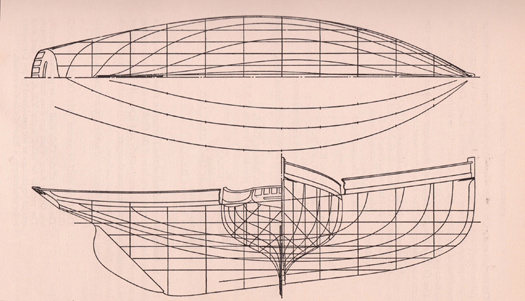
The lines of Jolie Brise are the ultimate development of the traditional pilot cutter type. LOA 56ft, LWL 48ft, Beam 15.7ft, Draft 9.5ft, 44 tons TM
Over the years she was so successful on both sides of the Atlantic that as they couldn't find the lines plan as drawn by Alexandre Paris for construction in the venerable Albert Paumelle's yard in Le Havre, they took them off the hull using traditional techniques. These days, you can use a system (developed in Ireland for taking the lines off historic wrecks) which does it with lasers. But back then it was a lovely yet painstaking job of working with sticks and string, and in Jolie Brise's case the lines are so lovely that I had them stuck up on the wall above the desk for years, and now keep them handy in the computer for ready reference when the lines of some modern boat look too ugly for words.
They're lovely, but archaic. She was the last of the line, and the best. The heavily angled rudder-post is a nonsense, yet it wouldn't look right any other way. And though she has a heavy hull, the water is left sweetly astern. For as the old Thames Barge skippers used to say, it's not the bow that is most important for easy speed, but the stern.
She's heavy, yet it's all of a piece with her type that the actual hull freeboard is low aft - it just doesn't look that way with the substantial bulwarks. But as designer Jack Laurent Giles said of her after crewing aboard in his younger years, when the wind was above Force 3 on Jolie Brise offshore, you needed to wear your seaboots, but were otherwise totally comfortably as the sea swilled merrily but harmlessly around your feet on the afterdeck.

Jolie Brise today, owned by Dauntsey's School since 1977, and used for sail training
She has been lucky at times to survive until her Centenary, but her life has been secure since 1977, when she was bought by Dauntsey's School in Dorset for sail training purposes. All credit to the school for taking on this absorbing challenge. But just as in times past Whitbread became the name of a major ocean race rather than a beer brand, so today there's a slight danger that Dauntsey's might be better recognized as the name of an organisation which runs one very special sailing ship, rather than a school.
Whatever, it's clear that Jolie Brise is one of those vessels which are just very special to sail aboard. Not simply because of her history, remarkable and all as that is, but more because of the technical and physical challenges of getting the best out of a wonderful old boat, and sailing her in a manner which respects the genius of the people who created her a hundred years ago.

The Fife One Designs in their home waters of the Menai Straits. In all, 33 boats have been built in wood or glassfibre to this 1926 William Fife design
In her purposeful traditional style, she'll make a neat contrast in Glandore with the 24ft LOA Fife One Designs, which thrive in their heartlands off Beaumaris in the Menai Straits. The boats were designed by William Fife III in 1926, and the class is in great heart, with 33 boats built, and wooden ones able to keep up the pace with a batch of glassfibre ones which were built by Dickie's of Bangor.
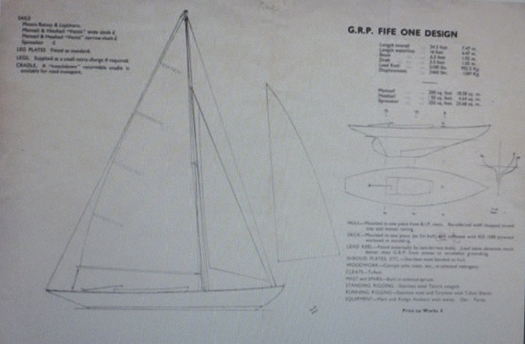
The glassfibre version was built locally by Dickie's of Bangor
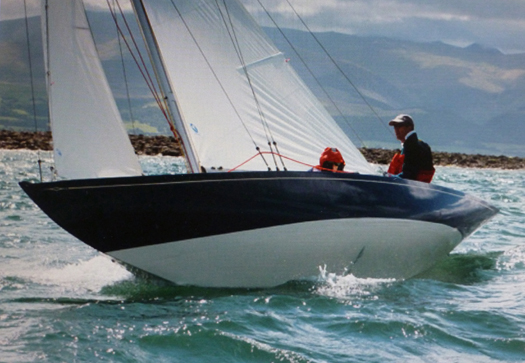
The Fifes are exceptionally pretty boats which suit their beautiful home waters
However constructed, they're exceptionally pretty little boats, and in view of comments we've had on this site in recent months about the narrow width of the side-decks on classics like the Dublin Bay 21s and the Belfast Lough Waverleys, it's interesting to note that the Fifes have wide side decks which enable them to sail at angles of heel which hugely impress the spectators, even if it limits speed and increases leeway.
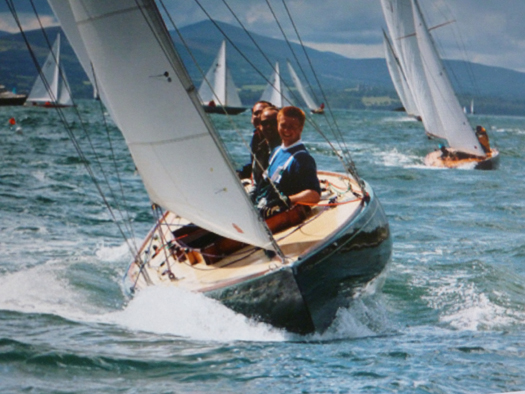
The side decks are exceptionally wide........
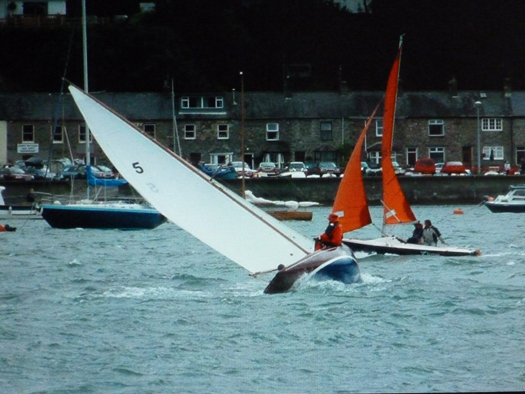
....which facilitates sailing at some extraordinary angles of heel.
Clearly the Royal Anglesey, their home club, has a membership of eclectic origins, as top helms recently have included Ewan McEwan and Mick McGarry. But despite these Scots and Irish intruders, the class is so closely identified with North Wales and projects such an attractive image for their area that when they go off on tour - as they've been doing for quite a few years now - the North Wales tourism body puts a bit of sponsorship the class association's way.
Now there's a thought. No boat is more clearly identified with one specific port than the Howth 17s. Howth tourism is under the umbrella of the Howth is Magic organisation. It's too late to do anything much this year, but next time the Howth 17s get a rush of blood to the head about going to some event, even, maybe Howth is Magic can wave a wand and come up with some readies.
As it is, the class - off their own bat - travelled by several flatbed trucks to Glandore Classics 2003, with 15 boats in all going to West Cork. It was a prodigious logistics achievement which I remember all too well as, in a period of mixed weather when the Seventeens insisted on doing their own thing with offshore races as well as in-harbour events, we found ourselves detailed off with our 35-footer to be one of the mother ships. The reason you're called the mother ship is because the mother is always the last to know Then as now, the Seventeens seemed to communicate by some sort of telepathy incomprehensible to anyone else.
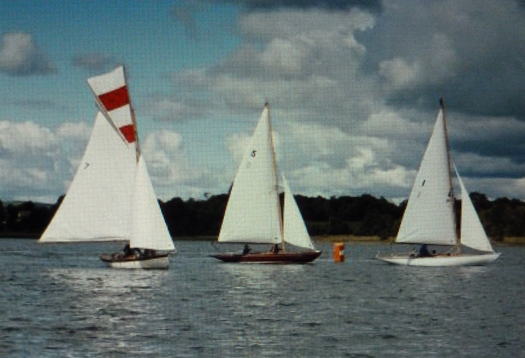
The only time the Howth 17s and the Fifes were together at a Classics Regatta was at Lough Erne in 2010
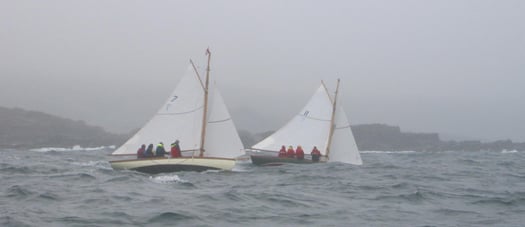
Howth 17s Aura and Deilginis racing out of Castlehaven bound for Glandore at the Glandore Classics 2003. Both boats have been in Cowes Classics this past week, but in very different weather. Photo: W M Nixon
Oddly enough, the only time the Fifes and the Howth 17s have been together was at the Lough Erne Classics in 2010, when the Fifes had a goodly number, but only thre Howth 17s flew the flag. And it has been just two Howth 17s – Aura and Deilginis - which made the journey to the Cowes Classics Inshore Classes event this past week, and as it has been plagued by calms, instead we'll use a picture of the 1970-built George McGruer ketch Cuilaun of Kinsale (Michael O'Flaherty & Brian Smullen) at the bigger boats Panerai Classics at Cowes last week.

The 1970-built Cuilaun (Michael O'Flaherty & Brian Smullen) at last week's Panerai Classics at Cowes. The boat in the foreground is a vintage Scandinavian 22 Square Metre.
But inevitably with all this local one design classes energy being spread separately at various events, you can't help but wonder if there might be an opening in Ireland for a dayboat Classic One Designs Regatta. It may well be that each class prefers to get undivided attention. But on the other hand, when you think of a regatta in which boats as diverse as Glens, Waverleys, Belfast Lough Fairies, Howth 17s, Strangford Lough Rivers, Lough Erne Fairies, Dublin Bay Mermaids, Water Wags and Cork Harbour One Designs are all racing on the same waters with their own starts, it has a certain appeal.
The first thing that a classic one design keelboat needs is a mooring. It is simply too undignified for them to be shunted in and out of a marina berth. And there's only one place I can think of where sufficient moorings could be laid in reasonable shelter, and that's at Strangford Lough YC at Whiterock. And this is a venue which might bring in the rather splendid 29ft River class sloops, designed by Alfed Mylne in 1919, thriving mightily as a local class these days, but emphatically not boats which have gone down the road trailering route like the Fifes.
The problem is that Whiterock lacks the necessary shore infrastructure of ample hotel accommodation near the anchorage. When you factor in the shoreside requirements, it becomes a very narrow target. So maybe the only option is with the National YC in Dun Laoghaire, for until the next phase of the harbour plan is implemented, there is space between the Carlisle Pier and the East Pier for temporary moorings off the National, while Dun Laoghaire can well cope with visitors seeking accommodation.
The success in June of Crosshaven's National 18s championship in Dublin Bay showed that the National can happily deal with strange classes. We can be quite sure there'd be nothing stranger than a gathering of all the Irish local one design classes (and the Welsh ones too, if they wish). It's an interesting thought. Meanwhile, good luck to the Fifes in Glandore, and the wonderful Jolie Brise too.


























